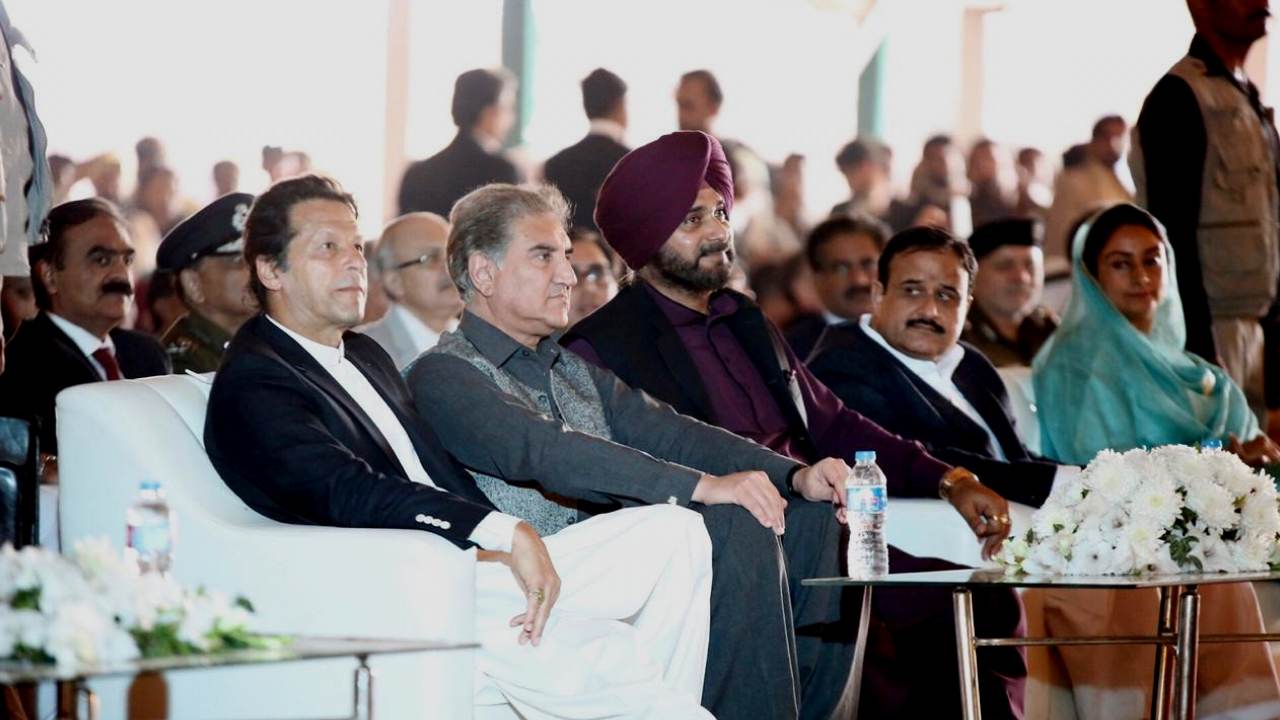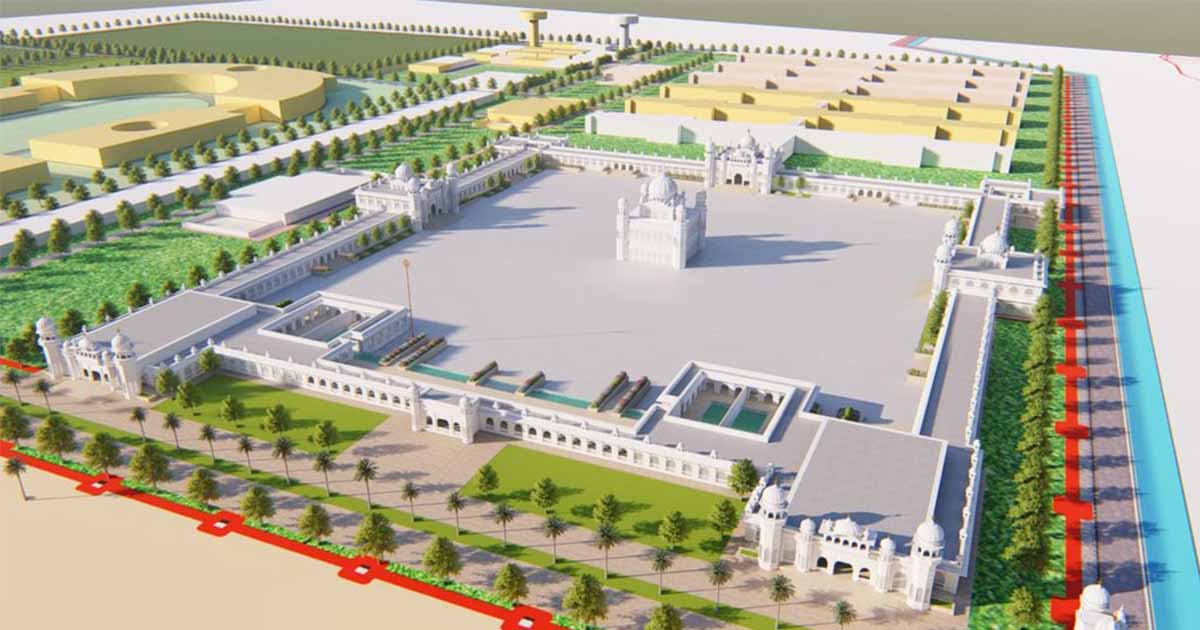Kartarpur Corridor is Pakistan’s initiative for peace, a decision to cement people-to-people contact, and an attempt to facilitate the Sikh community worldwide with unrestricted access to the shrine of Baba Guru Nanak, the founder of Sikhism. For the first time since 1947, Pakistan and India have signed a deal that will allow pilgrims from India to visit one of Sikhism’s holiest shrines in Pakistan without a visa.
The corridor, often called ‘peace corridor’ and a ‘peace zone,’ connects the Sikh shrines of Gurdwara Darbar Sahib Kartarpur in Punjab, Pakistan, and Dera Baba Nanak Sahib located in Punjab, India. Though Pakistan and India are still at loggerheads, especially on the Kashmir issue, many analysts cautiously express that the new entry point may lead to a thaw in relations between the two countries.
For decades, the Gurdwara Kartarpur Sahib remained off-limits to the Indian Sikh community, and pilgrims were forced to pay their respects from across the river, owing to the escalating tensions and deepening mistrust between the two South Asian rivals. Today, the time has changed, and, finally, Sikh Yatrees and others can visit Kartarpur throughout the year without obtaining a visa.
Prime Minister Imran Khan laid the foundation for the project last year with a ground-breaking ceremony held on November 28, 2018. Pakistan had vowed to make the corridor functional for the 550th birth anniversary of Baba Nanak, and one year later, the promise has been fulfilled.
Officials from Pakistan and India have agreed on a daily visa-free entry of as many as 5,000 Sikh pilgrims to Kartarpur Sahib Gurdwara throughout the year. Additionally, the authorities on both sides will grant permission to 10,000 Indians, intending to come to Pakistan to participate in the birthday celebrations of Baba Nanak.
Read more: Technical meeting on Kartarpur Corridor: India and Pakistan move towards peace?
Sikh visitors coming from India will not need passports but will still need valid ID documents. Pakistan will charge a $20 fee to visit the shrine from the Sikh visitors; however, this will be waived on the day of the inauguration, November 9, 2019, and on Guru Nanak’s 550th birthday, November 12, 2019
Indira Gandhi’s promise
In 1947, the Radcliffe Line divided the region between Pakistan and India. As per the Radcliffe Award, Shakargarh Tehsil on the right bank of the Ravi River, including Kartarpur, was given to Pakistan, and the Gurdaspur Tehsil on the left bank of Ravi was awarded to India. Following the partition, Indian Sikhs would visit Kartarpur informally by crossing a bridge on the river Ravi.
However, the bridge was destroyed during the 1965 war between the two countries. One year after partition, the Sikhs demanded that India should acquire the land of Gurdwaras in Nankana Sahib and Kartarpur. However, in 1959, the Indian National Congress advised against any modification of the boundary fixed by the Radcliffe Award.
Read more: The Kartarpur Corridor: Looking Beyond the Prism of Security and Geopolitics
Exactly 50 years ago, Indian prime minister Indira Gandhi first promised access to Sikh holy lands located in Pakistan. On the occasion of the 500th birth anniversary of Guru Nanak in 1969, PM Indira Gandhi, while addressing a meeting in New Delhi, assured the Indian Punjab state government that land-swap would be done with Pakistan for the purpose.
However, it never materialized. In September 1974, both the governments signed a protocol allowing visits to religious sites, excluding Kartarpur. Around 2005, the document was updated, and the number of sites was increased, yet Kartarpur was not included in it.
Bus Diplomacy & Kargil War
Officially, the opening of the Kartarpur border was first discussed during the tenure of Prime Minister Nawaz Sharif and Indian Prime Minister Atal Bihari Vajpayee in 1998. Subsequently, the Delhi-Lahore bus service – officially known as Sada-e-Sarhad – was started in 1999. As per the 1999 bus diplomacy, Pakistan renovated Kartarpur and made it available for viewing from the Indian border.

However, the Kargil war led to souring relations between the two countries. Later, in 2004, Indian Prime Minister Dr. Manmohan Singh raised the issue again, which led to the ‘composite dialogue process’ between India and Pakistan. This time around, both the governments discussed access to Kartarpur via an Amritsar–Lahore–Kartarpur road link.
It was reported that the former military ruler Gen (retd) Pervez Musharraf had given a ‘green signal’ for the construction of a corridor, but nothing materialized. Then in 2008, the idea of ‘visa-free travel’ to Kartarpur was discussed between Indian foreign minister Pranab Mukherjee and his counterpart Shah Mehmood Qureshi. However, the relations between India and Pakistan nosedived once again after the Mumbai attacks in November 2008.
Read more: Kartarpur land tilled by Guru Nanak himself to be preserved in Pakistan
Hug diplomacy
In August 2018, Chief of Army Staff General Qamar Javed Bajwa also expressed Pakistan’s willingness to open Kartarpur Corridor on Guruu Nanak’s 550th birth anniversary. Indian politician and former cricketer Navjot Singh Sidhu visited Pakistan to attend the oath-taking ceremony of his cricketer-turned-politician friend Imran Khan as the Prime Minister of Pakistan.

A political row erupted in India after Sidhu hugged Pakistan Army Chief at the occasion, he was tagged anti-national by Indian Twitterati as well as by India’s Punjab BJP president Shwait Malik. In his defense, Sidhu revealed that he hugged General Bajwa after the latter told him that Islamabad would grant access to Gurdwara Darbar Sahib on the birth anniversary of Guru Nanak.
In November 2018, the Indian Cabinet approved the plan to set up the corridor and appealed to Pakistan to do the same. Foreign Minister Qureshi responded by tweeting that Pakistan had “already conveyed to India” that it would open the corridor. In August 2019, India and Pakistan agreed to allow visa-free travel of Indian citizens to Kartarpur.
FWO’s remarkable triumph
A project first proposed in 1998, finally came full circle in the form of the new Kartarpur corridor project. The project that was to be completed in three and a half years has been completed in around ten months.
The Frontier Works Organization (FWO)’s impressive pace of development work on the Gurdwara, and the four-lane 4km long corridor has left many speechless. With a total of 408 acres of land being allotted to the Kartarpur Corridor itself, the major project has been completed at a record pace.
Officials from Pakistan and India have agreed on a daily visa-free entry of as many as 5,000 Sikh pilgrims to Kartarpur Sahib Gurdwara throughout the year.
The FWO was the primary contractor for the project in light of its unmatched experience in similar projects; it has been primarily responsible for the Karachi-Hyderabad motorway, Lyari Expressway, and countless other projects around the country. The FWO is the brainchild of the Pakistan Army Corps of Engineers that, in 1966, created this new organization specially equipped to deal with the mammoth task of constructing the Karakoram Highway (KKH).
Since successfully executing the unprecedented feat of engineering, the FWO has proved itself indispensable to the country’s infrastructure needs. It is hard to envision a project of such economic and strategic importance, bound to a strict time frame of completion, being undertaken without the professional experience of the FWO.
Read more: India must set aside Political Rhetoric & Show Flexibility on Kartarpur
Initially, 76 immigration counters have been set up to cater to the Sikh pilgrims who will come from India. These will be increased to 152 counters that will be built to serve over 10,000 pilgrims. The border terminal has been built 350 meters away from Zeropoint, and the pilgrims will be transported to the Gurdwara through buses where they will be given airport-like facilities.
History of Kartarpur Sahib
Baba Nanak had made Kartarpur his home in the 15th century, preaching here for the last 18 years of his life, it became home to the first community of Sikhs in the subcontinent. After his death in 1539, the site remained important for both Sikhs and Muslims, who revered Baba Nanak as an influential religious personality.
Kartarpur Sahib Gurdwara in Narowal is situated about 115km (71 miles) from Lahore. It is one of the most revered temples for the Sikh community, as it is Baba Nanak’s resting place. The distance between the temple and Gurdaspur is 4.7 kilometers (2.9 miles) from the Pakistan-India border.
The border terminal has been built 350 meters away from Zeropoint, and the pilgrims will be transported to the Gurdwara through buses where they will be given airport-like facilities.
However, the closure of the crossing forced Sikh pilgrims from India to travel hundreds of kilometers, via Amritsar and Lahore, to reach there. Pakistan’s Punjab province is home to some of the most important pilgrimage sites for Sikhs. It includes the birthplace of Baba Nanak, who was born in 1469 in Nankana Sahib district, and Gurdwara Punja Sahib in Hasan Abdal town, where the handprint of Baba Nanak is believed to be imprinted on a boulder.
The manner of the partition of British-ruled India in 1947 left a void amongst the religious and ethnic communities prevailing in the subcontinent. However, the Sikh community bore the most significant loss, as many of their holy sites fell in the Pakistani province of Punjab, of which, most notable, is the site of the founder of their religion, Baba Nanak.
Read more: AS Kartarpur Corridor near completion: BJP tries to take all credit
For decades, the Gurdwara Kartarpur Sahib remained off-limits to the Indian Sikh community, and pilgrims were forced to pay their respects from across the river, owing to the escalating tensions and deepening mistrust between the two South Asian rivals. Today, the time has changed, and, finally, Sikh Yatrees and others can visit Kartarpur throughout the year without obtaining a visa.
Delhi’s reservations on peace initiative
Initially, New Delhi had reservations over Pakistan’s ‘agenda’ to facilitate the Sikh pilgrims, and later, they had apprehensions over the committee formed to oversee the project, stating that the committee includes “Khalistani sympathizers.” After three rounds of shaky negotiations, the two countries, on October 24, 2019, signed the four-page Kartarpur Sahib Corridor Agreement, which is valid for five years.
Dr. Mohammad Faisal, the official spokesperson of the Foreign Office and Director-General South Asian and SAARC, signed the agreement with Mr. S.C.L Das, Joint Secretary of the Indian Ministry of Home Affairs at Zero Line, Pakistan-India border, Narowal.

Earlier in October, PM Khan claimed it was the “world’s largest gurdwara,” adding that the country would open its doors to Sikhs from across the world. “World’s largest Gurdwara will be visited by Sikhs from across India and other parts of the world,” he said, adding that the Kartarpur Corridor will be a significant religious hub for the Sikh community.
Read more: Pakistan & India Sign The Kartarpur Agreement At Zero Line, Narowal
A day after the Kartarpur agreement was signed, PM Khan laid the foundation stone for a university named after Baba Guru Nanak in Nankana district. “Setting up of an educational institution is the best way to pay homage to Baba Guru Nanak because education is the key to nations’ success,” Khan said while addressing the ceremony.
The international community, particularly the United States, has hailed Pakistan’s efforts for the Kartarpur project as it comes amidst a time of strained relations between the neighbouring countries after the military escalation in February, a major international row over Kulbushan Jadhav’s death sentence, and a three-month-long lockdown in Kashmir.
Rizwan Shehzad is the Assistant Editor, Global Village Space. He has previously worked with The Express Tribune. He tweets at: @RizwanShehxad.


